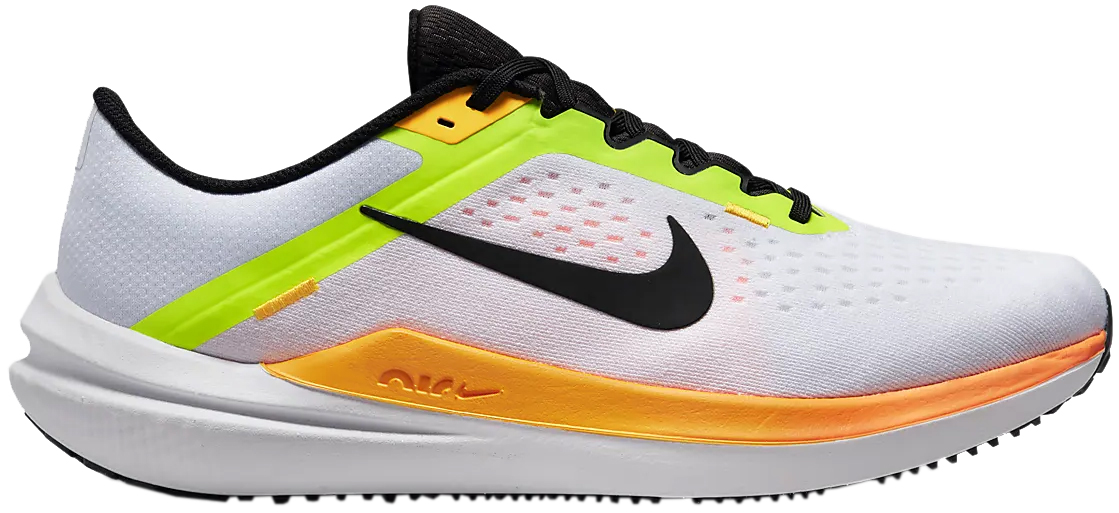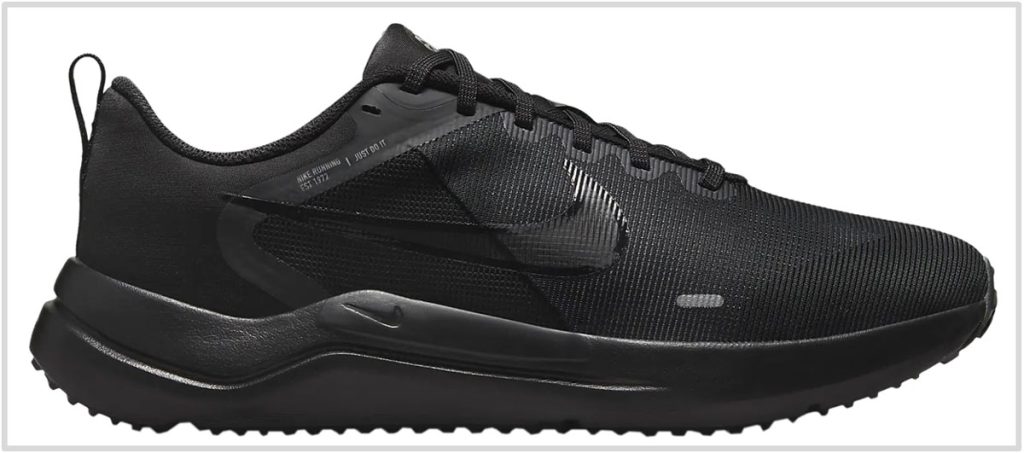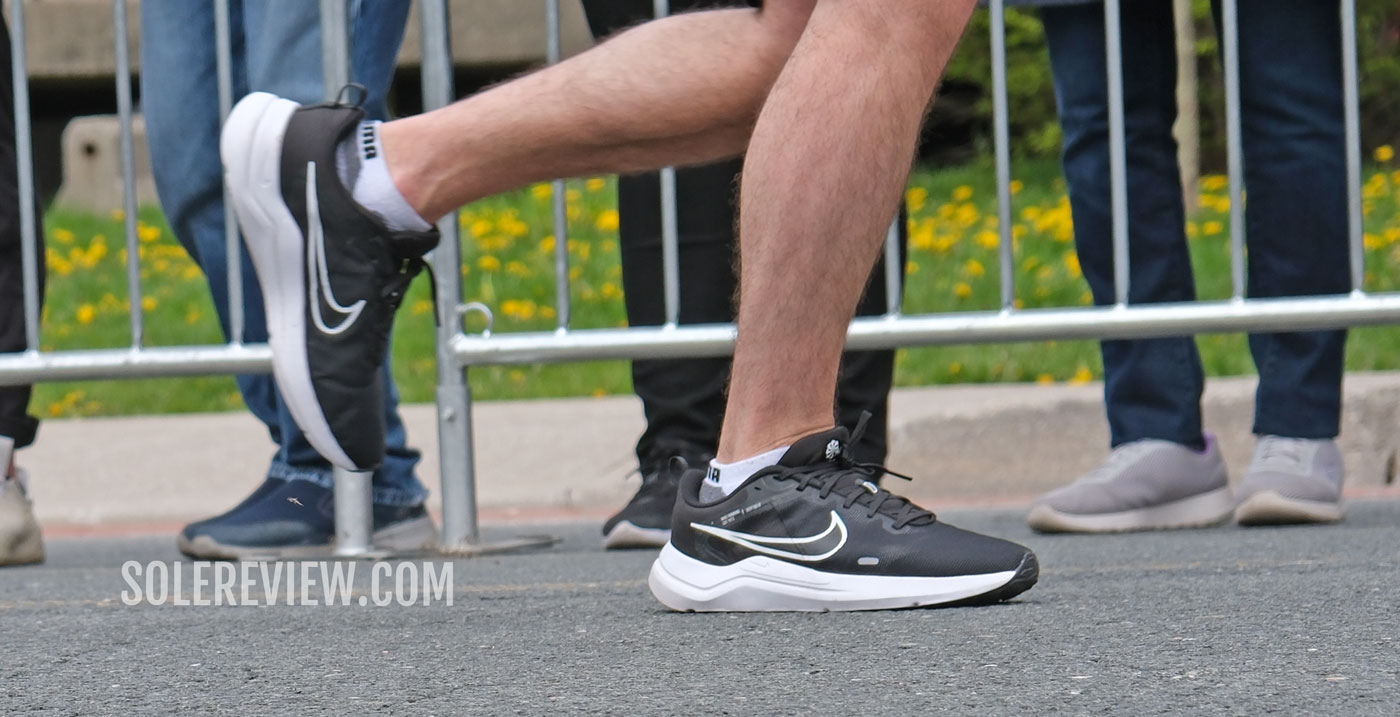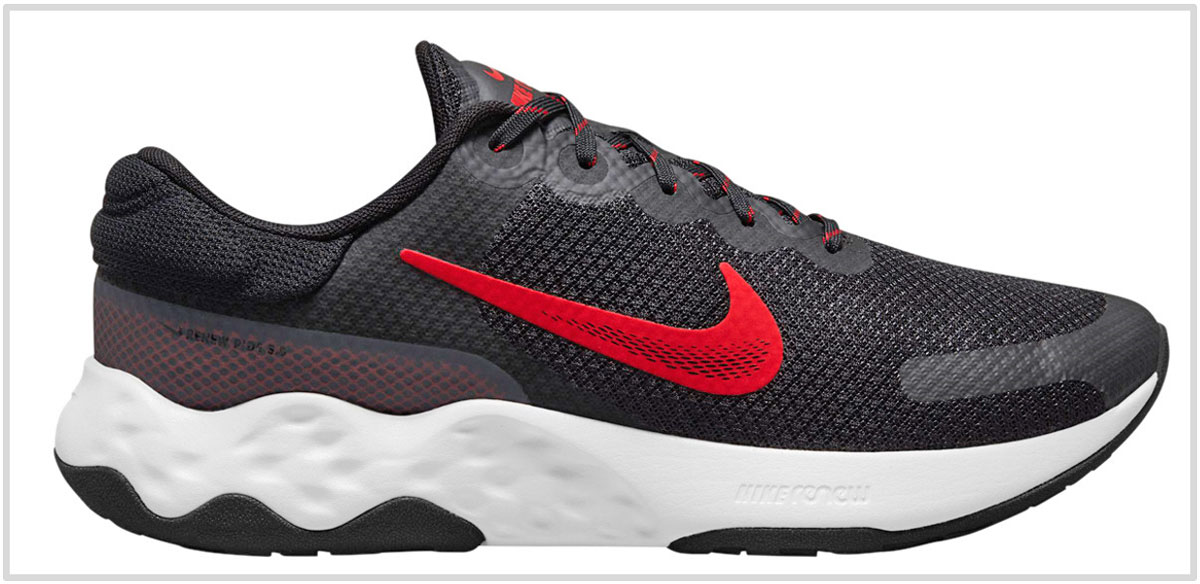This article has been updated with current models for November 2023. The Nike Interact Run and Saucony Convergence are new additions.
In this product guide:
- 1. Factors to consider
- 2. Affordable Nike everyday trainer: Nike Winflo 10
- 3. Affordable adidas everyday trainer: adidas Duramo SL
- 4. Affordable Brooks everyday trainer: Brooks Anthem 5
- 5. Affordable adidas everyday trainer: adidas RunFalcon 3
- 6. Affordable Asics everyday trainer: Asics Gel Excite 10
- 7. Affordable Nike everyday trainer: Nike Downshifter 12
- 8. Affordable Saucony everyday trainer: Saucony Cohesion 16
- 9. Affordable Nike flexible trainer: Nike Flex Experience 11
- 10. Affordable Nike everyday trainer: Nike Renew Ride 3
- 10. Affordable Nike everyday trainer: Nike Interact Run
- 10. Affordable trainer with 4 mm drop: Saucony Convergence
- 11. Affordable road-trail hybrid: Saucony Aura TR
There’s never been a better time to buy a running shoe.
For a very long time, entry-level models were a reluctant afterthought for running shoe brands. Except for shoes like the adidas Duramo, Saucony Cohesion, and Nike Downshifter, there weren’t many popular go-to products below $100.
In the past, budget prices also meant an entry-level material and technology package. The midsole was always a standard EVA foam block, and the upper designs were basic. 10 years ago, the situation was so dire that even a $100 shoe stank badly.
That has changed for the better.
At the time of writing this guide, many brands offer a slew of affordable products. adidas had a credible under-$100 assortment to begin with, and there are now many new models to choose from.
The future of affordable Asics running shoes also seems promising.
The Gel Contend used to be the only Asics running shoe (under $100) worth mentioning. It’s still in the line-up, but let’s be honest – the ultra-basic Contend 7 is visually disconnected from the new breed of Asics running shoes like the Novablast and Metaspeed Sky. The new Excite 10 borrows its modern aesthetics from the more expensive Cumulus.
The technology ‘trickle-down’ is a strategy that Nike has honed into an art form.
Nike products like the Winflo 10 lean heavily on the more expensive Pegasus for inspiration. Similarly, the Flex Experience 11’s design is based on the Nike Free.
So while running shoe prices can be downright ridiculous, there are plenty of competent models under $100.
And yet, most of the running shoes we hear about are expensive models. Brands spend their hype dollars on premium products, so the value assortment rarely receives marketing attention.
It’s important to talk about lower-priced running footwear because not all countries sell shoes at the same (US) retail prices.
A shoe priced at $100 stateside could cost $130-160 in international locations depending on the import duties and taxes – and that’s before taking the potential difference in purchasing power parity into account.
In other words, the same money that gets US-based consumers a brand-new Asics Nimbus or the Saucony Triumph will only fetch a ‘budget’ running shoe in many countries.
The search for a sub-$100 shoe can get confusing, so we’ve curated a selection of 10 running shoes that retail for under $100. However, the final selling price will depend on the retailer and your location.
We also recommend searching for deals on the older versions of popular trainers.
In most cases, the previous model is available for less than $100. It’s worth keeping track of when new models are introduced, because the previous versions usually go on markdown sales around that time. Our release date tracking calendar is a helpful resource.
So what we’re saying is – instead of buying shoes from this guide, it’s a better idea to get a higher-tier shoe (like the Asics Cumulus, Nike Pegasus, or Saucony Ride) for a cheaper price. The older models can be often had for less than $100.
1) Nike Air Winflo 10
The Nike Winflo 10 no longer has the word ‘Zoom’ in it, and that’s because it has the full-length Air midsole that debuted on the Winflo 9.
This lightly pressurized Air bag delivers a soft and comfortable ride that feels more consistent than the single Zoom Air bag set-up of the Winflo 8 and prior.
This Air bag is inside a soft EVA foam midsole, so that makes the Winflo 10 a comfortable and lightweight trainer for everyday runs. The raised midsole sidewalls add support by cupping the foot.
The snug upper has a strap-based lacing system (similar to the Pegasus 40) for a secure lock-in. However, optional widths aren’t available. Though the Winflo retails for $100, there are usually deals to be had – which effectively lowers its price into double-digit territory.
As both the Winflo 10 and 9 share the same midsole, it isn’t a bad idea to get the previous model for a cheaper price.
Nike also sells a water-resistant ‘Shield’ variant of the Winflo 9 for the colder months.
2) adidas Duramo SL
The Duramo SL is still a $70 running shoe, and that’s a rare feat in this era of price inflation. Also, this is the only shoe on this guide with an optional wide sizing.
And this shoe isn’t mere lip service to the idea of a running shoe. Many bonafide features make it a fully functional running shoe for everyday training.
Even though the midsole isn’t made of high-tech materials, the EVA foam (aka Lightmotion) stack is sufficiently cushioned for medium-distance runs and treadmill workouts. The firm ride and adiwear rubber outsole also make it stable and durable.
The mesh upper is surprisingly well-equipped for its price. The tongue and heel are padded, and the snug mesh shell has a smooth interior with a secure lacing set-up. The welded 3-stripes logo and stitch details add decorative contrast.
3) Brooks Anthem 5
The Brooks Anthem 5 is a basic running shoe that works for mild-intensity runs. Under the breathable and true-to-size mesh upper is an EVA midsole made of Brooks BioMogo foam – a material that was originally used on older versions of the Brooks Ghost and Glycerin.
When combined with the foam insole, the midsole makes the ride comfortable enough for short-distance runs (up to 10K).
The midsole isn’t very thick, so the cushioning has a firm quality to it. Not surprisingly, the Anthem 5 also works for tempo runs at 4:00 min/km (6:30 min/mile) paces.
Overall, the Anthem feels similar to some of the older (and firmer) Brooks Launch models.
4) adidas RunFalcon 3
The RunFalcon 3 is as basic as a running shoe can get. This $65 entry-level trainer has an all-mesh upper mated to an EVA foam midsole.
The shoe may look plain, but the design is fundamentally sound. The flared Achilles heel grips the heel softly without slippage, and the mesh upper breathes well and creates a smooth interior.
Unlike more expensive adidas models, the midsole isn’t made of Boost, but of ‘Cloudfoam’ EVA foam. It’s comfortable and stable enough for daily use, and that’s the reason why this shoe features here.
There’s a full rubber outsole for durable traction. However, it’s not a Continental rubber kind.
5) Asics Excite 10
From the outside, the Asics Excite 10 resembles the latest Cumulus 25. However, the $85 price means that the Excite doesn’t share any performance parts with the more expensive Cumulus. What we have here is a basic running shoe with basic ingredients.
For example, instead of Flytefoam Blast, the Excite 10 has an EVA foam (Amplifoam) midsole with a rearfoot Gel pad insert. Like the Excite 9, an Ortholite insole comes standard. Overall, the Excite 10 isn’t particularly ‘exciting’, but works well as an everyday trainer for up to 10K runs.
The engineered mesh shell without any overlays offers contemporary styling with a smooth interior.
Its $85 retail price makes the Asics Gel Excite 10 excellent value. Thanks to price inflation, the sticker is up $5-10, depending on when you acquired your Excite 9.
6) Nike Downshifter 12
Until recently, the Downshifter was a $60 shoe. This year, it’s a $70 shoe – thanks to inflation.
The Downshifter is one of the many sub-$100 shoes in Nike’s catalog, and has been around for nearly a decade. It is one of Nike’s best value-for-money performance running shoes. The Nike Dart used to be the ultimate no-frills shoe but it was discontinued (in 2017?) after 12 long years.
It feels like a long time, but the Dart was originally a $45 running shoe, and a pretty good one at that. Anyway, we digress.
There are no fancy foam components or Zoom Air bags on the Downshifter; just a comfortable foam midsole that is paired with a near-seamless upper. The resulting product is a functional, everyday running shoe.
The rubber outsole and its waffle-shaped lugs make the Downshifter durable and traction-friendly. The Downshifter 12 uses a brand new midsole and outsole, as both the Downshifter 10 and 11 got visual updates inspired by the Vaporfly. The Downshifter 11 is based on the same sole unit but with a different upper – so not much has changed.
The no-sew upper has a sleek exterior that uses a thin mesh and fused overlays for support. The midfoot panels are vented to keep the interiors cool during runs. The fit runs a bit narrow, but the Downshifter sells in a wide as well.
Also see: The Quest 5, Revolution 6.
7) Saucony Cohesion 16
The Cohesion has been a regular fixture on our affordable shoe lists. This isn’t just about the price; the Cohesion 16 is a no-frills running shoe that covers most bases.
The Cohesion won’t win prizes at a beauty contest, but it has a solid and well-fitting (albeit snug) upper, a cushioned and supportive ride, and is durable. And what’s more, the 9-ounce weight makes it pretty lightweight too. Just know that Cohesion 16’s midsole has a high 12 mm heel-to-toe offset – if that matters for you.
Its $75 retail price gives you more shoe per dollar and is proof that you don’t need to spend a fortune to get a functional pair of running shoes.
And by the way, if you’re looking for a 2E (wide) sizing in the Cohesion, Saucony sells that too.
Also see: The Asics Gel-Contend 8.
8) Nike Flex Experience Run 11
The Flex Experience Run 11 is heavily inspired by the Nike Free’s outsole and upper design. Most of the original Nike Free line no longer exists, so the Flex Experience is what you should buy if you want the flexible midsole experience.
This geometry delivers a unique quality of cushioning and transitions, as it’s very flexible in the front and supportive under the heel. The ride is also sufficiently cushioned, so these traits make the Flex Experience Run 11 an excellent trainer for everyday runs.
The soft and pliable upper is a perfect match for the flexible midsole. There are no superfluous layers that restrict the range of motion, and the interiors fit smoothly while locking the foot over the midsole.
9) Nike Renew Ride 3
The way we see it, the Nike Renew Ride 3 is an ultra-budget version of the ZoomX Invincible. Of course, there’s no ZoomX foam – this is a $80 shoe that borders on athleisure.
Regardless of the composition, the EVA foam midsole does what it’s supposed to. It’s a cushioned neutral trainer that works for daily runs and casual wear. Inside, the soft insole adds a layer of step-in comfort.
The mesh upper has a snug and smooth fit with a plush heel collar and tongue. A wrap-around midsole makes the ride stable by cupping around the heel.
The cushioned midsole is protected by a two-piece rubber outsole for traction and durability.
10) Nike Interact Run
There are many sub-$100 shoes on this list, so why add another $85 product here?
The Nike Interact is the only running shoe on this guide with a Flyknit-inspired upper. With this design, the Interact Run punches above its price segment. The upper has other useful features like a reflective heel strip and pull tab that are usually unavailable in this price band. The QR code on the tongue is an overkill, though.
Like many affordable trainers, the Interact Run is ideal for low-intensity runs and athletic activity. The true-to-size upper keeps the foot locked down, and the EVA foam midsole has enough cushioning for short runs. You get a full outsole as well, with rubber covering the entire contact area.
The midsole borrows its deep scoops from the React Infinity 4, but the foam is neither React nor ZoomX, so there’s a lack of bouncy softness found in more expensive shoes.
12) Saucony Convergence
If the softer-than-before Kinvara 14 isn’t to your liking, consider the Saucony Convergence. It uses the same midsole as the Kinvara 12 and 13, so you get the familiar firmness from the 4 mm drop midsole. While it’s missing Kinvara trims like the Pwrrun+ (expanded PU) foam footbed, it retains the tempo-friendly ride of the past Kinvaras.
The firm EVA foam midsole is good for runs of up to 10K, and is exceedingly versatile. It’s easy to pick up speeds, so the Convergence is an affordable interval trainer as well as a daily trainer.
The Convergence is a $70 product, so the upper is built to a cost. Specific examples of cost-cutting would be the use of basic upper materials and plain (non-printed) insole. The finer details aside, the upper does its job well – which is to keep the feet from sliding. The interior may be basic, but is smooth and breathable.
12) Saucony Aura TR
The Saucony Aura TR is a new $75 shoe that offers more than the basic road-trail form factor.
For starters, the Aura doesn’t share the outsole design with an existing road running shoe. The thick rubber outsole has a trail-oriented lug design that works well on off-road terrain.
The Aura isn’t the trail shoe for technical terrain, but will do perfectly fine on unpaved flats, gravel or chip trails, and gentle slopes. The EVA foam midsole has adequate cushioning for general off-road use.
The layered upper is protective with a snug fit. The ripstop-like mesh and stitched overlays shield the foot while keeping the debris out. And if you want a waterproof version, there’s a Gore-Tex variant available as well.
Also see: The Saucony Excursion TR 16.
Do you own any of these shoes? Improve this review by sharing your insights – submit a review here.















